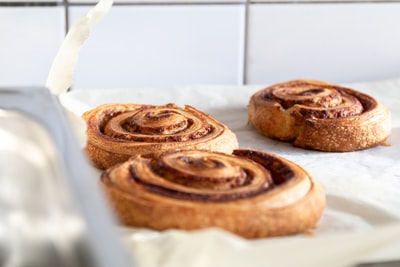Ingredients
- 6 egg yolks
- 3 eggs (whole)
- 750 gr flour
- 450 gr butter
- 300 ml milk (cold)
- 38 gr sugar
- 4 gr vanilla
- 3 gr salt
- 2 gr orange rind (grated)
- 1 gr cardamom seeds (ground)
- 2 packages dry yeast
-cold When making Danish pastry it is important to keep the dough very cold. In shaping small pastries, it is sometimes necessary to re-chill partially shaped dough until it is firm enough for the job to be completed. When you first make the pastry, be careful to follow all the rules. Don't make it in the summertime unless your kitchen is air conditioned. After you gain experience you may attempt short cuts such as rolling out and folding the dough twice in succession without re-chilling. Another way of shortening the process is by placing the dough in the freezer between rollings. Usually 10 minutes in the freezer is suffiecient. When you use this short cut, be careful not to freeze the dough solid. The shaped pastries can also be chilled in the freezer. They can even be baked frozen if extra baking time is allowed. Any unbaked yeast pastries, however, should never be kept frozen for more than a week or so; and it is preferable to bake anish pastry within a day or two after it has been shaped. Place 4 cups flour in large bowl. Reserve remaining flour for rolling. Make a well in center of bowl. If dry yeast is used, see directions on package. If fresh yeast is used, cream it with sugar and salt to make a syrup. Add egg yolks or whole eggs, grated orange rind, ground cardamom seeds, and vanilla. Pour yeast mixture into well. Add one cup milk and quarter cup butter cut into pieces. Mix with finger tips, adding more milk if necessary to make a medium-soft dough. Knead dough in bowl for 5 minutes, or until it is smooth but not elastic. Flour it and let rest in refrigerator for 30 minutes. While dough is resting, form remaining butter into a flattened brick. Using some of the reserved flour on wax paper or pastry cloth, roll out butter into a square about 1 cm thick. Use plenty of flour under and on top of butter to keep it from sticking. Loosen it frequently as you rol. Cut the square in 2 pieces. Place in refrigerator between sheets of wax paper. Roll out dough on well-floured cloth to make a rectangle 3 times longer than wide and about 1 cm thick. Brush excess flour from dough. Place a piece of butter in center. Fold one end of dough over butter. Place remaining butter on top. Fold second end over the butter. Press edges together. Turn dough, changing its position so that the short ends are parallel with the edge of table nearest you. Roll out on well-floured cloth, using a firm, even motion to spread butter together with dough. Try to work quickly, but check frequently underneat the dough to be sure it isn't sticking. Roll out a rectangele 3 times longer than wide, about 1 cm thick. rush excess flour from surface. Fold both ends of dough to meet in center. Press edges together, then fold in half as if closing a book, which will make 4 layers of dough. Flour dough. Place on a cooky sheet. Cover with aluminum foil. Refrigerate for half hour. Repeat rolling and folding dough 3 more times, chilling it 20 minutes between rollings. Be sure to change position of dough each time so that the short ends of dough are parallel with the edge of the table nearest you when you start rolling. After the final folding, chill dough at least 3 hours before shaping and baking.

